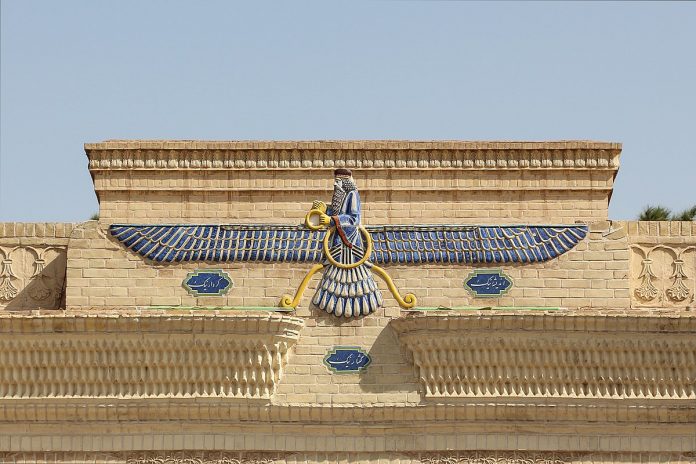Today (21.03.2018) the Persians and other Iranians around the world will wish to each other “happy 1397”! The number of the year should not deceive you: the celebration of the Persian New Year goes back many centuries before the beginning of the Western Common Area. The reduced date is due to several modifications that took place in modern times.
The Persian New Year is called Nowruz in Persian (Farsi) a word that literally means “new day”. It is of course no coincidence that the Persian New Year is celebrated at the very moment vernal equinox occurs. Nowruz is a festivity with roots to the pagan past of the ancient land of Iran.
Although nowadays Iran hits the headlines as a country of strong Islamic faith and fervent anti-American resentment, Iran and its people are much more than that. The main ethnic group, the Persians, speak a language which is quite distinct from the neighboring Arabic. In fact, Persian (or Farsi) is an Indo-European language, relative to English, German, Greek, Latin, Sanskrit and so on. Even the name ‘Iran’ actually means “(the land) of the Aryans”!
Nowruz, and the Spring Equinox, take place tomorrow at 12:15 pm (New York Time) or 16:15 UTC. The Iranians, celebrate the New Year with lavish banquets. The days before a good spring house cleansing and shopping take place. The last Wednesday before the Nowruz Iranians light bonfires called Chaharshanbe Suri, roughly meaning ‘Reddish Wednesday’.
The Zoroastrianism
Despite the fact that the Islamic government of Iran does not approve of these festivities, these are deeply rooted to all Iranians, irrespective of their faith.
The majority of Iranians follow the Shia branch of Islam. A small community, which numbers some tens of thousands of believers (around 25.000), belong to the original ancient religion of Iran. Its name is Zoroastrianism. This is where Nowruz festivity also stems from. Although Zoroastrianism is just a minimal community in today’s Iran, it was once the principle religion of the ancient Persian kingdoms. It is also the religion that has influenced the traditions and the folklore of the Iranian people the most.
Due to the diaspora of the Zoroastrians, the majority of them is outside Iran. There is an important community in India of about 50.000 believers. Worldwide, the number of Zoroastrians is estimated at about 190.000 adherents.
Ahura Mazda and Zarathustra
The designation ‘Zoroastrianism’ comes from the name ‘Zoroaster’, an ancient Greek rendition of the name of Zarathustra. You have probably heard of Nietzsche’s masterpiece Thus Spoke Zarathustra. Well, like in the modern book, Zarathustra was considered to be a prophet who preached the truth of Ahura Mazdâ, the greatest deity in the Iranian pantheon. From the name of the principle God, the religion is traditionally called mazda-yasna, which literally means “he who sacrifices (performs a ritual of offerings) to Ahura Mazdâ.”
Contrary to Jesus or Mohamed, Zarathustra is not a historical figure, in the sense that we do not have reliable records about his physical existence. According to the tradition, he brought the truth of Ahura Mazdâ to the mortals at the beginning of time.
But what is the truth of Ahura Mazdâ? Contrary to other Pagan religions of Eurasia, Zoroastrianism displayed a strong duality between the Good and the Evil. Ahura Mazdâ conducts an eternal war against the Evil Spirit, the Angra Mainyu and the Old Gods, the daêwas. This fight began with the creation of this world. While Christian theologians tried to explain the root of Evil in a world in which God is omnipotent, for Zoroastrians the Evil is part of the world that will be however defeated at the end.
“Good Thoughts, Good Words, Good Deeds”
The role of humans in this fight is to assist Ahura Mazdâ in his war against the Evil by thinking good thoughts, uttering good words and doing good deeds.
These three principles stand on Faravahar, a symbol representing a “guardian angel” (Fravashi) that can be found on the Zoroastrian temples in and outside Iran. It is a presentation of the “winged-sun”. It is a symbol of great power and it serves also as a manifestation of (non-Muslim) Iranian nationalism.
According to the way they act, people may enter the paradise or get into hell. However, at the end of times, all people will live in paradise. Therefore, hell is a sort of Purgatory.
In the theology of Zoroastrianism, one can see some thoughts that became fundamental in Gnosticism later.
Mithra & Anâhitâ
There are two more important deities on the “good” side.
Mithra is a Sun deity that fights the darkness in this world, literally and metaphorically.
Anâhitâ is the heavenly river, presumably the Galaxy (Milky Way). She is also the divinity of the Waters, an element that plays an important role in Zoroastrian rituals (along with fire). She is the greatest female deity associated with fertility, healing and wisdom.
The Fire temples and the Cosmic Order
The battle against the Deception and Lie demands an active participation to the rituals of the religion. The Rituals take place in places of worship called “Fire Temples”. Holy Fire (Atar) is central is the main means of spiritual purification. The ritual is called Yasna. The process of the rituals is basically described in Gathas. These books were written in the Avestan language after centuries of oral transmission. Avestan is a language close related to the ancient Indian language of Vedic and Sanskrit.
The Holy Fire is a manifestation of Ahura Mazdâ and His Asha, the Cosmic Order. Asha is a concept of great importance. The translation ‘Order’ does not cover all connotations that the term has in this religion. Like the Greek term Logos, Asha encompasses theological, cosmological and moral concepts.
So, in case you have Persian friends, don’t forget to wish them “Nowruz mobarak!”, a Happy New Persian Year. And happy Spring Equinox to everyone!
Phaethon
Readings:
There is a very interesting short academic introduction available on Internet from the lectures of Prof. Prods Oktor Skjærvø at Harvard.
The scholarship on the topic is evidently large.

